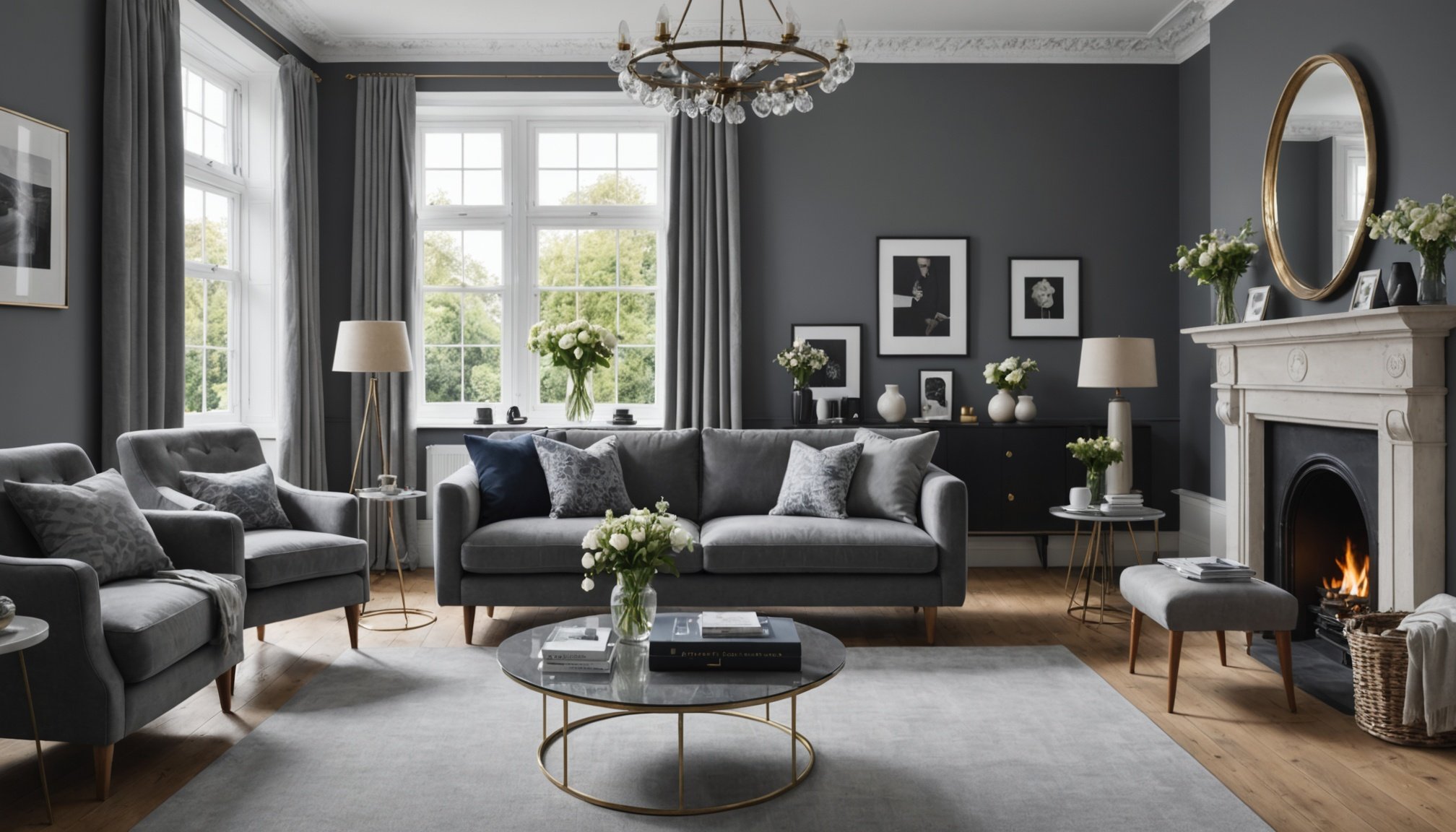Choosing the perfect colour for your living room can be a challenging task. It’s not just about selecting a colour you love, but also one that complements your furniture, lighting, and overall interior design. Among all the colours, grey has emerged as an all-time classic and sophisticated choice for modern UK homes. Its diverse range of shades, from light silver to charcoal, can create a warm, inviting space while giving the room a refined, elegant look. But how do you choose the right shade of grey for your living room? Let’s delve into it.
Understanding Grey and its Impact
Before you swipe that credit card on cans of grey paint, it’s essential to understand the colour and its various hues. Grey, a mix of black and white, encompasses a spectrum of shades that can convey different moods and atmospheres.
Lire également : Selecting the Ideal Wallpaper for Your Timeless Victorian UK Bedroom: A Comprehensive Guide
Light grey colours project a calm, serene ambiance suitable for a living room intended as a relaxation space. They also make the room look larger, drawing in natural light and reflecting it around the room. On the other hand, darker shades of grey can create a dramatic, intimate atmosphere, ideal for a cosy, lounge-like living room.
Moreover, the colour grey is generally considered neutral and can blend well with most other colours, making it a versatile choice for your living room.
A lire aussi : Seamless Integration of Smart Home Tech in UK Grade II Listed Buildings: A Comprehensive Guide
The Impact of Lighting on Grey Color Selection
One crucial factor to consider when choosing grey for your living room is the room’s lighting. Natural and artificial light can drastically alter the appearance of grey paint on your walls.
In rooms with plenty of natural light, darker shades of grey can help balance the brightness and create a warm, inviting space. However, in rooms with limited natural light, lighter shades of grey are more suitable as they reflect more light and prevent the room from appearing too dim or gloomy.
Artificial lighting, too, plays a significant role. Warm lights can bring out the yellow or red undertones in grey paint, giving the room a cosy, inviting glow. In contrast, cool lights can highlight blue or green undertones, creating a more modern, crisp look.
Complementing Grey with Other Colours
Complementing grey with the right colours is essential for achieving a harmonious interior design. Grey can work well with a wide range of colours.
Pairing light grey walls with white furniture and accessories can create a fresh, airy space. Contrarily, a darker grey can be beautifully contrasted with bold, vibrant colours like blue or red for a more dramatic look.
Remember that the colours you choose should not only match your grey walls but also reflect your personality and design aesthetics.
Visualising Grey in Your Living Space
Before making the final decision, it’s always a good idea to visualise how the grey will look in your living space. Most paint retailers offer sample pots, which you can use to paint a small section of your wall and observe how the colour changes in different light conditions throughout the day.
There are also numerous online tools and apps that allow you to upload an image of your room and digitally paint the walls with your selected shade of grey. These tools can give you a good idea of how the final result will look and help you choose the perfect shade of grey for your living space.
Finalizing Your Grey Living Room
Once you’ve chosen the perfect shade of grey, it’s time to finalize the look of your living room. Adding textured fabrics, mirrors, metallic accessories, and artwork can enhance the sophistication and elegance of your grey living room.
Remember, the goal is to create a space that feels warm, inviting, and distinctly you. So, take your time, consider all factors, and most importantly, enjoy the process of transforming your living room into a sophisticated, grey-hued haven.
Choosing the right shade of grey for your living space is an art. It needs a keen eye for detail and an understanding of how colours interact with light and other elements in the room. But once you get it right, you’ll be rewarded with a living space that not only looks elegant and sophisticated but also feels warm, inviting, and distinctly you.
The Role of Interior Design Elements in a Grey Living Room
Your choice of grey should also be influenced by other interior design elements in your living room. Furniture, flooring, and accessories can all impact how the grey paint will look in the room.
For instance, if your room includes warm-toned wooden furniture, a grey with warmer undertones would complement it better. However, with cool-toned furniture like pieces with metal accents, a grey with blue or green undertones might work well.
It’s also essential to consider the colour scheme of the entire room. If you’re working with a monochromatic palette, you might choose to stick within the grey family, using different shades for the walls, furniture, and accessories to create a soothing, layered look.
On the other hand, if you’re looking for a bit more contrast, combining grey with other colours can create a striking design. For example, grey walls paired with mustard yellow, emerald green, or navy blue accents can make a bold statement.
When it comes to flooring, a darker shade of grey can help hide dirt and stains, making it a practical choice. Lighter carpets or wooden floors can also pair well with grey walls, providing a nice contrast and making the room feel more spacious.
Remember, the key is to strike a balance where the shade of grey complements your furniture, flooring, and overall colour scheme to create a harmonious look.
Creating an Elegantly Grey Living Room: The Wall Finish
The finish of the grey paint can also significantly impact the overall look of your living room. There are typically four types of finishes to choose from: matte, eggshell, satin, and gloss.
A matte finish has no shine and can give your living room a chic, contemporary feel. However, it can be tricky to clean, so it might not be the best choice if you have pets or young children.
An eggshell finish has a slight sheen and is more durable than a matte finish, making it a good option for high-traffic areas like living rooms. Satin finishes are slightly glossier than eggshell finishes and are also easy to clean, making them a practical choice for everyday living.
A gloss finish is the shiniest and most durable, but it can highlight imperfections on the wall. Therefore, it’s best used on smooth, well-prepared surfaces.
Choosing the right finish for your grey walls depends on your lifestyle, the condition of your walls, and the look you want to achieve. A Benjamin Moore or Farrow & Ball consultant can provide expert advice on which finish would best suit your needs.
Conclusion
Creating a sophisticated grey living room involves more than just picking a shade of paint. It requires careful consideration of the room’s lighting, the other colours in the room, your interior design elements, the paint finish, and how all these factors will interact with one another.
Remember to test your chosen shades of grey under different lighting conditions and visualize them in your space using sample pots or online tools. This will help ensure that you’re completely satisfied with your choice before you commit to it.
Finally, personalize your space by adding textures, patterns, and accents that reflect your style. A beautiful mirror, a piece of metallic artwork, or a bold, colourful cushion can all add a final touch of elegance and sophistication to your grey living room.
Choosing the right shade of grey for your living room is a journey, but it’s one that’s well worth it. With patience, careful consideration, and a dash of creativity, you can transform your living room into a sophisticated, grey-hued haven that’s truly your own. Happy decorating!











